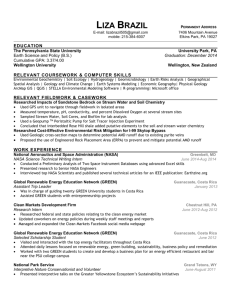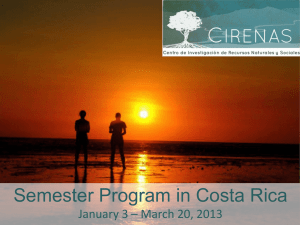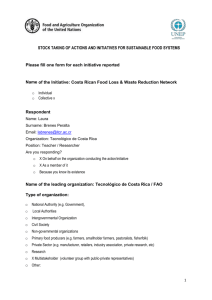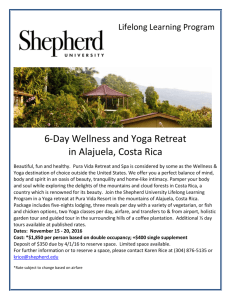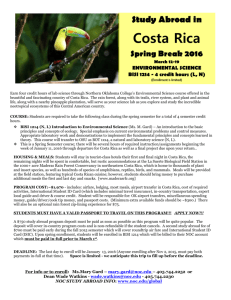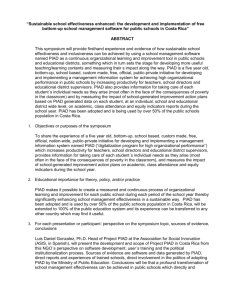Costa Rica a wonderful country
advertisement
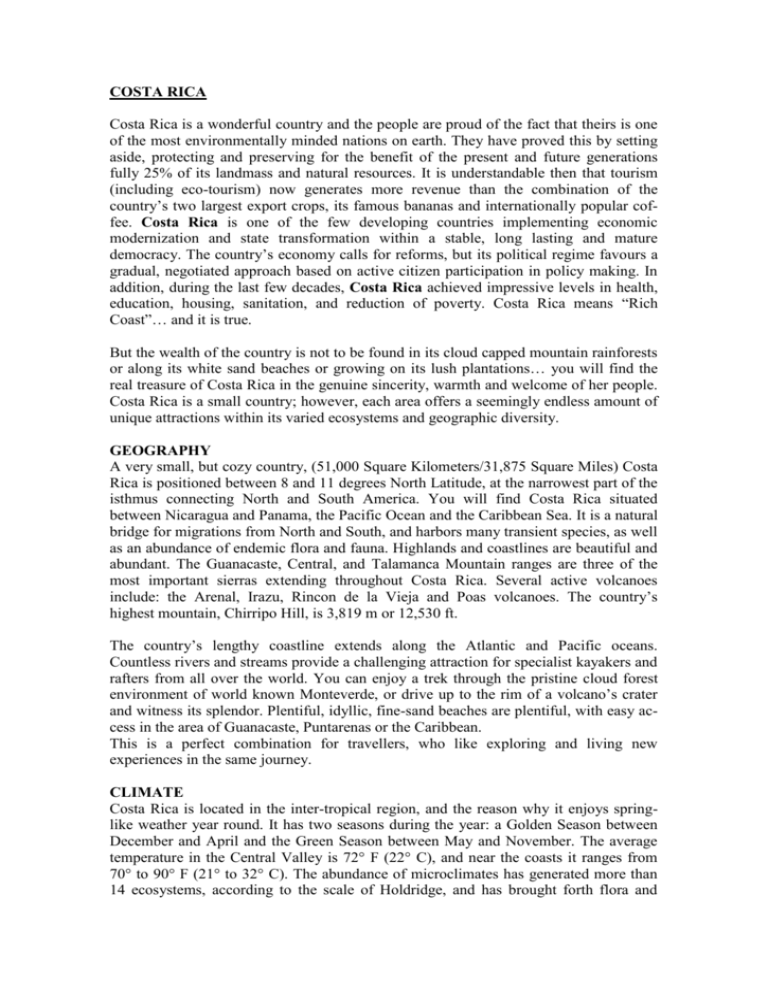
COSTA RICA Costa Rica is a wonderful country and the people are proud of the fact that theirs is one of the most environmentally minded nations on earth. They have proved this by setting aside, protecting and preserving for the benefit of the present and future generations fully 25% of its landmass and natural resources. It is understandable then that tourism (including eco-tourism) now generates more revenue than the combination of the country’s two largest export crops, its famous bananas and internationally popular coffee. Costa Rica is one of the few developing countries implementing economic modernization and state transformation within a stable, long lasting and mature democracy. The country’s economy calls for reforms, but its political regime favours a gradual, negotiated approach based on active citizen participation in policy making. In addition, during the last few decades, Costa Rica achieved impressive levels in health, education, housing, sanitation, and reduction of poverty. Costa Rica means “Rich Coast”… and it is true. But the wealth of the country is not to be found in its cloud capped mountain rainforests or along its white sand beaches or growing on its lush plantations… you will find the real treasure of Costa Rica in the genuine sincerity, warmth and welcome of her people. Costa Rica is a small country; however, each area offers a seemingly endless amount of unique attractions within its varied ecosystems and geographic diversity. GEOGRAPHY A very small, but cozy country, (51,000 Square Kilometers/31,875 Square Miles) Costa Rica is positioned between 8 and 11 degrees North Latitude, at the narrowest part of the isthmus connecting North and South America. You will find Costa Rica situated between Nicaragua and Panama, the Pacific Ocean and the Caribbean Sea. It is a natural bridge for migrations from North and South, and harbors many transient species, as well as an abundance of endemic flora and fauna. Highlands and coastlines are beautiful and abundant. The Guanacaste, Central, and Talamanca Mountain ranges are three of the most important sierras extending throughout Costa Rica. Several active volcanoes include: the Arenal, Irazu, Rincon de la Vieja and Poas volcanoes. The country’s highest mountain, Chirripo Hill, is 3,819 m or 12,530 ft. The country’s lengthy coastline extends along the Atlantic and Pacific oceans. Countless rivers and streams provide a challenging attraction for specialist kayakers and rafters from all over the world. You can enjoy a trek through the pristine cloud forest environment of world known Monteverde, or drive up to the rim of a volcano’s crater and witness its splendor. Plentiful, idyllic, fine-sand beaches are plentiful, with easy access in the area of Guanacaste, Puntarenas or the Caribbean. This is a perfect combination for travellers, who like exploring and living new experiences in the same journey. CLIMATE Costa Rica is located in the inter-tropical region, and the reason why it enjoys springlike weather year round. It has two seasons during the year: a Golden Season between December and April and the Green Season between May and November. The average temperature in the Central Valley is 72° F (22° C), and near the coasts it ranges from 70° to 90° F (21° to 32° C). The abundance of microclimates has generated more than 14 ecosystems, according to the scale of Holdridge, and has brought forth flora and fauna that range among the richest on the planet. A wide variety of flora and fauna (5.4% of the planet’s plant and animal species), beautiful landscapes, and an everchanging climate will delight travellers’ senses in this everlasting-spring country. ECONOMY At the beginning of 1980s, Costa Rica initiated a process of promotion of exports, insertion in the international markets, reform of the state and elimination of distortions that were preventing our country from competing with the rest of the world as part of a set of initiatives that gave birth to the new development model, which main target was the insertion of the country in the international economy. During the last years, Costa Rica has specialized in the attraction of high technology companies intensive in human capital; as a result, many important companies have established here: Dole, Firestone, Baxter and the most outstanding case of success, Intel. There are also business centers such as Procter and Gamble, Western Union, Hewlett Packard, Sykes. Before the economic restructuring process initiated in the early 1980s, the Costa Rican economy was depending basically on a few export products: banana, coffee, sugar and meat, which now represent a significant portion of total exports. Non-traditional agricultural export products have shown a fast development during the last decade; among them palm, orange, roots and tubercles (yucca, yam, “tiquisque”, malanga), ginger, pineapple, and ornamental plants. Coffee was historically the country’s most important crop, and Costa Rica continues to produce some of the finest quality coffee in the world. Bananas continue to be one of the most important export produce that is grown on vast plantations in the Caribbean lowlands. Tourism has generated more than any single export crop and the tourism industry, continues to grow providing new employment opportunities and stimulating the conservation of our complex biodiversity. We could say that Costa Rica’s basically stable economy depends on tourism, agriculture, and the manufacturing sector (textiles, paper, electric/ electronic, metal-mechanics, plastic, food).Costa Rica’s army was abolished in 1948, and the money the country saves by not having armed forces is invested in improving the standard of living, which has fostered the social harmony that makes it such a pleasant country to visit. EDUCATION In Costa Rica, education is public and free. Its government has long dedicated a significant portion of the national budget to enhance the minds and bodies of its citizens, a policy that has fostered a healthy and knowledgeable population. The country has a literacy rate, and an average life expectancy, that are much closer to those of Western European nations than most Latin American countries. Costa Rica has had a socialized health system for nearly half a century; while schools, universities, and medical centers are strategically located throughout the country. HERITAGE & CULTURE Costa Rican culture is, in many ways, a reflection of its racial mix. The predominant influence has long been European, which is reflected in everything from the official language, Spanish, to the architecture of the country’s churches and other historic buildings. The indigenous influence is less apparent, but can be found in everything from tortillas, served with a typical Costa Rican meal, to the handmade ceramics sold at roadside stands. Costa Rica is a Central American success story. Since the late 19th century, only two brief periods of violence have marred its democratic development. Spain colonized this territory more than five hundred years ago, and for that reason most of the population is still Catholic. ITS PEOPLE In Costa Rica, there are more than 4,412.474 people including immigrants from Nicaragua, Cuba, Colombia, North America, Europe and China. Almost half of the population lives in the Central Valley. One element is absolutely certain: Costa Rica’s most important asset is her people. Kind and hospitable, “Ticos”, as Costa Ricans are commonly known, set themselves apart when it comes to assisting travellers. Whether its helping you with complicated road directions, or helping you find a good place to eat, Ticos will go out of their way to assist any visitor. Polite, and well educated, Ticos are quick to greet you with a smile. Once you have experienced their friendliness and spontaneity, you will no doubt agree. POLITICAL SYSTEM Costa Rica is a democratically elected republic. Its system of government is very similar to that of the United States of America or other democratic country. There are three branches of government: the Executive, which consists of the president, two vice presidents and ministers or secretaries of state; the Legislative Assembly, or Congress, with 57 individually elected members; and the Judicial Branch which consists of civil, criminal, appellate and constitutional courts. The President and members of the Legislative Assembly are elected for a four-year period. Presidential re-election is possible and the suffrage age is 18. HEALTH & MEDICAL FACILITIES You do not have to worry neither about most of the diseases that anyone may expect to encounter in a tropical country nor about a vaccination card (not necessary to enter the country). Costa Rica has an impressive network of public healthcare facilities including 29 hospitals, 92 clinics, and 839 local primary care medical consultation offices (EBAIS). The system, known as the “Caja Costarricense de Seguro Social”, or simply “Caja”, offers universal public healthcare coverage for all Costa Rican workers and their families. Medical facilities in Costa Rica feature the same sophisticated tests, equipment and procedures found in other developed countries, and are available at considerably lower costs. Should one of our guests require medical services, while in Costa Rica, there are hospitals and private clinics in major cities to provide the highest standards of professional care and treatment. The concierges at large hotels will, in all likelihood, be able to provide an in-house doctor. If an emergency arises, always call 911.In addition, there are pharmacies providing 24-hour service in main cities. ENTRY REQUIREMENTS Costa Rica is accessible by land, sea and air. There are two international airports: Juan Santamaría in Alajuela, near San José, and Daniel Oduber Quirós, just outside Liberia, Guanacaste in the Northwest part of the country. There are ocean ports that fully meet international standards: Limón, and Moín on the Caribbean, and Caldera and Puntarenas on the Pacific Coast. It is also possible to enter Costa Rica from Panamá and Nicaragua by car, or on any of the international bus lines such as “Tica Bus” or “Trans Nica”. Both provide daily service from Guatemala to Costa Rica and Panamá. To enter Costa Rica, every visitor is required to have a passport with a validity of, at least, six (6) months. Completed immigration and customs forms, which are also required, will be surrendered upon entry. Upon leaving Costa Rica, the departure tax is currently US $26.00 per person. CURRENCY AND EXCHANGE FACILITIES The official currency is the Colón. The exchange rate varies daily in relation to the U.S. dollar. Dollars and travelers checks are easily exchanged at hotels and banks. Most major credit cards such as AMEX, VISA and MASTER CARD are accepted at hotels, large stores and restaurants. The US Dollar is also widely accepted throughout Costa Rica. COMMUNICATIONS AND ELECTRICITY Costa Rica has a very advanced communications system with telephones and fax machines throughout the country. You can easily find Internet connections in most every city and town, as well as in business centers at major hotels. The mail service is very good, too. There are more than a hundred post offices all over the country. National and International newspapers and magazines are sold in the streets and shopping centers. Power is a standard 110 volts all over the country, with 220 volts available in newer hotels. It is always important to check before connecting any electrical devices. Europeans, visiting Costa Rica, should bring an adaptor with them. ATTIRE Light casual clothing is recommended all year round. When visiting the city, bring pants, a light jacket or sweater and comfortable walking shoes. In the Central Valley, the evening shadows bring cooler temperatures (60° to 70° F).When going to the beach, do not forget your shorts, t-shirt and tevas. Mountain gear is: pants, light jacket and hiking shoes. But no matter where you go, try not to forget your swimsuit, sunscreen, cap, insect repellent, sunglasses, and raingear. Remember that travellers will be exposed to different climates, geographical and weather changes. TIME ZONE Six hours (-6) behind Greenwich Mean Time. No Daylight Saving Time.



